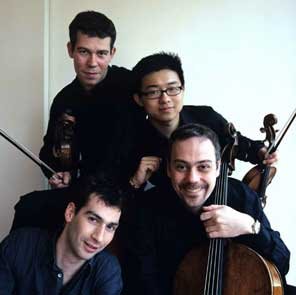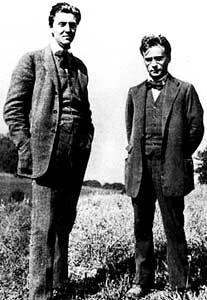Quatuor Diotima
 La Maison Française, in the person of its cultural attaché, Roland Celette, champions the cause of contemporary French composition by hosting a Contemporary Music Series. During the latest concert in that series, given by the Diotima String Quartet on Monday night, M. Celette announced that the series will continue and even be expanded. Next year, the Embassy of France will join with other embassies in Washington to present a series of concerts of European contemporary music at the Hirshhorn Museum. Of course, we will have more information about that development as it happens.
La Maison Française, in the person of its cultural attaché, Roland Celette, champions the cause of contemporary French composition by hosting a Contemporary Music Series. During the latest concert in that series, given by the Diotima String Quartet on Monday night, M. Celette announced that the series will continue and even be expanded. Next year, the Embassy of France will join with other embassies in Washington to present a series of concerts of European contemporary music at the Hirshhorn Museum. Of course, we will have more information about that development as it happens.
At the London String Quartet Competition in 2000, the Quatuor Diotima received the Contemporary Music Prize, and they have embraced new music as their particular specialty. The young Frenchmen came back to Washington, after an appearance last summer playing chamber works by Pascal Dusapin, with another program of thorny modern works. They play this music -- dissonances, nontraditional sounds, complicated form or apparent lack of it, and all -- with expertise, a natural hand, and a full palette of dynamic and articulative color. This comes, I imagine, from playing a lot of this music regularly and from residencies and other opportunities to work directly with the composers of the pieces they play.  They opened with a golden oldie, Anton Webern's Six Bagatelles, op. 9 (1911-13), the first of which was nothing more than a few whispered, murmured scratchings. Webern began studying with Schoenberg in 1904, and in this period, they were still working out the new atonal, eventually 12-tone system of composition. Paul Griffiths has written that Webern's recollection of the Six Bagatelles was one of anguish because of their brevity: he quotes Webern as remembering, "While working on them I had the feeling that once the 12 notes had run out, the piece was finished." The composer concluded that this piece "sounds grotesque, incomprehensible, and it was immensely difficult." The strength of Diotima's playing of this admittedly inhospitable music is strong rhythmic coordination among the players and a range of sounds from skeletally sotto voce, almost nothing, to a full shriek.
They opened with a golden oldie, Anton Webern's Six Bagatelles, op. 9 (1911-13), the first of which was nothing more than a few whispered, murmured scratchings. Webern began studying with Schoenberg in 1904, and in this period, they were still working out the new atonal, eventually 12-tone system of composition. Paul Griffiths has written that Webern's recollection of the Six Bagatelles was one of anguish because of their brevity: he quotes Webern as remembering, "While working on them I had the feeling that once the 12 notes had run out, the piece was finished." The composer concluded that this piece "sounds grotesque, incomprehensible, and it was immensely difficult." The strength of Diotima's playing of this admittedly inhospitable music is strong rhythmic coordination among the players and a range of sounds from skeletally sotto voce, almost nothing, to a full shriek.
If the Webern was a horseradished amuse-gueule -- like so much of that composer's music, over before you know it -- we then dug into the full meal of Alban Berg's Lyrische Suite (1925-26). (Jens heard this piece last November at the Freer.) If the birth of the serial process was a difficult one, by this point -- after the wonder of Wozzeck -- we hear that Berg had hit his stride. Theodor Adorno identified the Lyric Suite's six movements, each delineated in character and tempo, as a "latent opera." As described by George Perle, Berg said that "progressive changes in the structure of the original 12-note series in the course of the work [imply] 'submission to fate'." A copy of the miniature score of the Lyric Suite, thickly annotated by Berg and rediscovered in 1977, reveals the "libretto" of the secret opera, Berg's love affair with Hanna Fuchs-Robettin. Although it's hard to pick out, he even quoted from Wagner's Tristan und Isolde in the final movement. For this work alone, the first and second violinists (Naaman Sluchin and Yun-Peng Zhao on the Webern) reversed roles, which to their credit had little impact on the overall sound. The tangle of competing melodies was unwoven with great skill, giving contrapuntal clarity to the individual lines. Percussive, almost hollow sounds alternated with glassy runs that shattered into shards. The rich sweep of Berg's lush sound can sound like a neotonal film score at moments, and here it did. The first half concluded with String Quartet No. 2 (1979-80) by Brian Ferneyhough (b. 1943), whose recent "thought opera" Shadowtime Jens heard last summer. This piece is dominated by the motif of siren-like glissandi, wailing up and down, giving the impression of someone tinkering with an ancient radio. The odd, faint light of the embassy's dark auditorium -- I sometimes worry that performers there are going to go blind -- added to the feel of the work as something happening in a World War II bomb shelter. This odd piece was matched by the first work on the second half, Silent Flowers (1998) by Toshio Hosokawa (b. 1955), whose opera Hanjo I wrote about two summers ago. Hosokawa's score is a series of vignettes separated by long silences, often announced by violent group pizzicati leading into long crescendi on unison notes, growing into explosive metallic sounds. In the final section, the music rose higher and higher in glissandi, ultimately evaporating on the first violin's E string.
The first half concluded with String Quartet No. 2 (1979-80) by Brian Ferneyhough (b. 1943), whose recent "thought opera" Shadowtime Jens heard last summer. This piece is dominated by the motif of siren-like glissandi, wailing up and down, giving the impression of someone tinkering with an ancient radio. The odd, faint light of the embassy's dark auditorium -- I sometimes worry that performers there are going to go blind -- added to the feel of the work as something happening in a World War II bomb shelter. This odd piece was matched by the first work on the second half, Silent Flowers (1998) by Toshio Hosokawa (b. 1955), whose opera Hanjo I wrote about two summers ago. Hosokawa's score is a series of vignettes separated by long silences, often announced by violent group pizzicati leading into long crescendi on unison notes, growing into explosive metallic sounds. In the final section, the music rose higher and higher in glissandi, ultimately evaporating on the first violin's E string. In a gesture meant to connect their difficult program with the tonal tradition, the concert closed with Leoš Janáček's second string quartet. This so-called "Intimate Letters" quartet (not identified as such in the program) was completed in 1928, in the middle of the composer's work on his final opera, From the House of the Dead. It was not performed publicly until after he was dead. Its extended but still mostly traditional harmony contrasts with the modernistic colors, like many sul ponticello passages, rendered with dry energy by cellist Pierre Morlet. Violist Franck Chevalier brought a strong sound to the many solos, often crafted like wistful remembrances of tunes presented earlier in the work, entrusted to his instrument. This repertory is not the Diotima Quartet's strength, but it did provide a convincing conclusion to a fine concert at the French embassy.
In a gesture meant to connect their difficult program with the tonal tradition, the concert closed with Leoš Janáček's second string quartet. This so-called "Intimate Letters" quartet (not identified as such in the program) was completed in 1928, in the middle of the composer's work on his final opera, From the House of the Dead. It was not performed publicly until after he was dead. Its extended but still mostly traditional harmony contrasts with the modernistic colors, like many sul ponticello passages, rendered with dry energy by cellist Pierre Morlet. Violist Franck Chevalier brought a strong sound to the many solos, often crafted like wistful remembrances of tunes presented earlier in the work, entrusted to his instrument. This repertory is not the Diotima Quartet's strength, but it did provide a convincing conclusion to a fine concert at the French embassy.
Upcoming events at La Maison Française include a screening of Danièle Thompson's new film Fauteuils d'orchestre (Monday, April 17, 7 pm), a concert of 17th-century French music by Ensemble Doulce Mémoire, directed by Denis Raisin Dadre (Monday, April 24, 7:30 pm), and violist Antoine Tamestit and cellist Alexis Descharmes in a concert of contemporary, mostly Hungarian music (Friday, April 28, 7:30 pm).





















































2 comments:
Exceptionally fine review of a difficult but important concert, Charles. Thank you very much for your work.
With ionarts.org having now supplanted the Washington Post as the authoritative cultural/critical voice in Washington for music, I have high hopes for contemporary music in Washington over the next generation.
*
By the way, Toshio Hosokawa also composed a chamber opera for Munich entitled 'Vision of Lear', which is set in modern day Tokyo and concerns a bardophile Japanese office worker having a nervous breakdown in a corporation undergoing radical restructuring. I don't believe the opera is on Michael Kaiser's and the Kennedy Center's agenda for a Terrace Theater production next Spring.
Garth, thanks for the kind words. We're not worthy. And thanks for the information about Hosokawa's other opera. Something to watch for.
Post a Comment